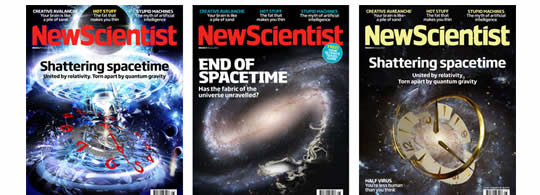Neuromarketing at New Scientist

For a field that some pundits dismiss as pseudoscience, neuromarketing scored a coup when New Scientist had Neurofocus optimize their cover design, and then wrote about the process. To be sure, the well-regarded science mag was cautious in its commentary, but they were happy to claim to be the world’s first neuromarketing-influenced magazine cover.
For our experiment, we tested three alternative covers on 19 male subjects who sometimes buy New Scientist at the news-stand. They saw each cover for a total of 36 seconds, and each image was followed by a series of written words to test whether the covers had primed them to the concepts “eye-catching”, “intriguing” and “must-buy”.
Once the testing was complete, NeuroFocus ran the data through what Smith calls its “secret sauce analysis” to produce an overall score of their neurological effectiveness. The average score for target material put through this analysis is 5 out of 10. All our covers did better than that but the winner did particularly well, with a score of 8.2. NeuroFocus recommended we use it. So we did. [From New Scientist – Mind-reading marketers have ways of making you buy by Graham Lawton and Clare Wilson.]
The New Scientist article provides some nice background on neuromarketing and the differences between fMRI and EEG as used for neuromarketing.
That the selected cover (center image) proved to be more engaging doesn’t seem all that shocking. The other two covers have the same text, “Shattering Spacetime,” compared to the rather apocalyptic “End of Spacetime” on the winner. The alarming tone in the latter cover is enhanced by the subhead, “Has the fabric of the universe unraveled?” While logic would tell us that the universe didn’t self-destruct when we weren’t looking, the idea of such a disaster is no doubt more interesting to the threat-monitoring firmware in our brain.
While the New Scientist article promises that a future post will let us know how well the selected cover sells, the data won’t be particularly meaningful without a control group. If only the scientifically-minded folks at the magazine had held out for a split-run test that included a “losing” cover design, we’d have a great case study to report on in a month or two.

